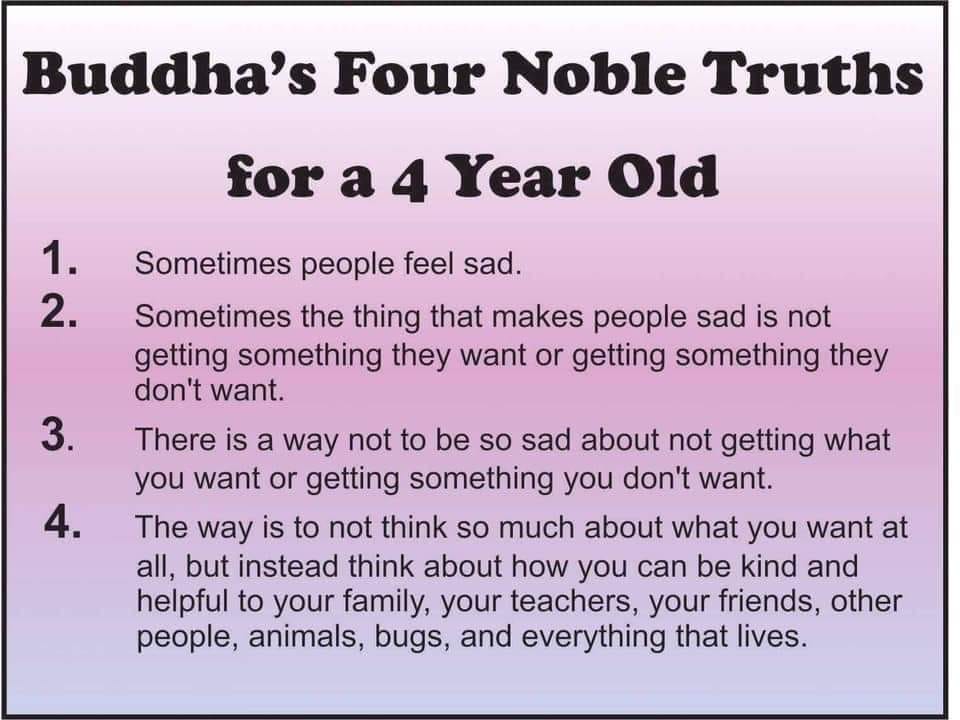
I often find that in Buddhism and Zen, we can easily overcomplicate the teachings. But the truth is, the Buddha’s message is actually very simple — so simple that even a child can understand it. That’s exactly what I want to do today: explain the Four Noble Truths in a straightforward, relatable way.
To make this even easier, I’ll be sharing something I found a while back called "The Four Noble Truths for a Four-Year-Old". But first, let’s briefly walk through the original Four Noble Truths as taught by the Buddha, from a practicing perspective rather than an intellectual one.
The Four Noble Truths: A Clear Explanation
1. Life Is Dissatisfactory
The first Noble Truth traditionally states that "life is suffering." But I think a more helpful way to understand it is: life is dissatisfactory.
Not getting what we want is dissatisfying.
Getting what we want — but then losing it — is dissatisfying.
Getting what we want, but still wanting more or wishing it were different — again, dissatisfying.
Birth, aging, illness, death — these are all examples.
Even when a baby is born, the first thing it does is cry, not laugh! This tells us a lot. Also, being around people we dislike, or being separated from those we love — all of this is part of life's dissatisfaction.
2. The Cause of Dissatisfaction Is Craving
The second Noble Truth points to the cause of all this dissatisfaction: we don’t understand ourselves. When we don’t understand ourselves, we grasp, cling, hold on, and push away.
We want things to be a certain way. We try to hold on to pleasure and avoid discomfort. This craving keeps us trapped in a cycle of disappointment and dissatisfaction.
3. There Is a Way Out
The good news is that the third Noble Truth tells us there’s a way out of this cycle.
We don’t have to stay stuck. Freedom is possible.
4. The Path to Freedom Is the Eightfold Path
The fourth Noble Truth describes eight practices that leads to the end of dissatisfaction — the Eightfold Path. Let’s go over it quickly:
The Eightfold Path (In Three Parts)
Wisdom:
- Right View: Perceiving this moment clearly, without clinging to fixed ideas or opinions. It's not about "right vs. wrong", but about seeing the truth of cause and effect in the present moment. Another way of labeling this point is "clear view." Sometimes in Zen, we call it "no view."
- Right Intention: Why do you eat every day? Why do you live your life? The first of the Four Great Vows is, Sentient beings are numberless; we vow to save them all. This means setting a clear direction or purpose for our life — to help all beings.
Ethical Conduct:
- Right Speech: Are my words true? Are my words serving a purpose in this moment? Are they helpful? Speaking in ways that bring clarity, compassion, and understanding.
- Right Action: Acting in ways that cause less harm and more healing in the world. We bring action to our intentions. In Zen, there is a wonderful teaching: One action is better than a thousand words.
- Right Livelihood: Earning a living in a way that aligns with our practice and vow. We are using our karma to help others, rather than allowing our karma to cause more suffering.
Meditation:
- Right Effort: Having the courage to look at this moment honestly. Showing up moment to moment whether practice feels easy or difficult. Making an strong effort to meet and respond to this moment accordingly.
- Right Mindfulness: Being aware of our words, actions, and mind habits, and how they affect the world.
- Right Concentration: Staying anchored and grounded in the present moment, even when life feels chaotic. Though strong thoughts and feeling may appear, they are not pulling us around.
The Four Noble Truths for a Four-Year-Old

Now, here’s that simple version I mentioned earlier. I'm not sure who originally wrote this — if you know, please let us know!
-
Sometimes people feel sad.
We can also say people feel disappointed, angry, or frustrated. It's something we all experience. -
Sometimes people feel sad because they don't get what they want, or they get something they don't want.
Simple, clear — and not even Buddhist, really. It’s just about the human experience. -
There is a way not to be so sad about not getting what you want, or getting something you don't want.
Relief is possible. We are never truly stuck. -
The way is not to think so much about what you want, but instead think about how you can be kind and helpful to your family, friends, teachers, animals, bugs, and everything that lives.
In other words, shift your energy outward — to connection, action, and skillful means.
A Small Clarification
One note: when it says, "The way is not to think so much about what you want," it's important not to misunderstand that. It’s not about suppressing our desires or forcing ourselves to stop wanting. If we try to push thoughts and feelings away, they only come back stronger.
Instead, the practice is about where we place our energy and attention. Do we cling tightly to our desires, or can we release that grip and focus on what’s happening right now? How can we help — right here, right now?
In fact, if I had to boil down the entire teaching of Buddhism into one simple phrase, it would be:
"What is happening right now, and how can I help?"
Final Thoughts
These teachings aren’t just for Buddhists, monks, or Zen practitioners — they’re for all of us. They’re about the human condition: making life clearer, more compassionate, and more engaged.
I’d love to hear what you think about this teaching — especially the version for a four-year-old!
Please leave a comment below or like this post if you found it helpful.


